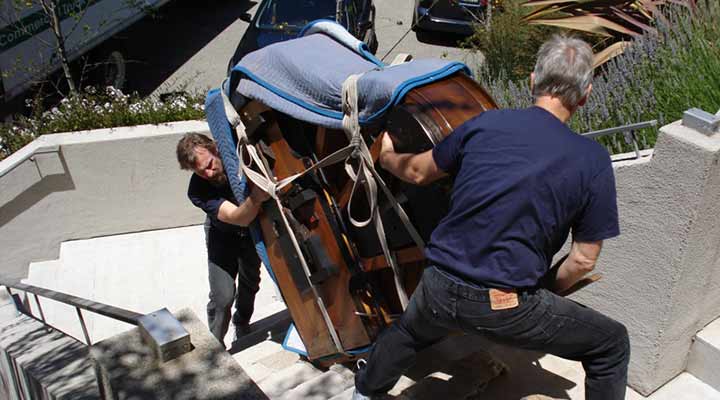
How to Move a Piano and Store One Properly
Mar 31, 2023 / Alyssa Duranty
After schlepping thousands of uprights and grands for five generations, the Aldens can safely say they know a thing or two about how to move a piano.
“If you think you can do it on your own, give it a shot,”; said Nate Alden of Alden’s Pianos. “People could tackle smaller pianos on their own, if they have the right kind of equipment.”;
[youtube id=”fho3VK5dNaA”]
If you’re up for the challenge of moving a piano, or even if you just want to know how to prepare your instrument before the professionals take it away, keep reading for tips from the pros. And don’t forget to check out our piano moving tips video! Soon you’ll be singing and playing sweet, sweet music in your new space!
Invest in Piano Moving Supplies or Pro Movers
If you want to move your piano on your own, you’ll likely want to invest in some professional supplies to make sure your black and whites get home in one piece.
You may be able to find a piano dolly – one with specialized pieces to hold fragile pianos – for rent in your neighborhood. Otherwise, you might want to buy one. Shop around and then compare those prices to the cost of professional piano movers.
“Buying the supplies may cost you as much as hiring professional movers who already have one,”; Alden said.
Movers may be your best option if you’re moving a baby grand piano, which can be cumbersome. The legs and pedals need to be removed and the interior as well as the exterior need to be padded before moving, said Alden.
“Call a local piano mover and have them walk you through it,”; he said. “But what we can do in 10 to 20 minutes could take you 3 to 4 hours.”;
Measure and Photograph Your New Space
Before you or your professional movers pick up your piano, make sure it will fit into your new home by measuring the entryways, hallways and stairways.
“Moving a piano is not like moving a couch; you can’t just carry it,”; said Alden. “It has to be maneuvered in a specific way, because when you’re moving a 600-pound instrument and if it touches a wall, you’re going to have damage.”;
If you are hiring professionals, take photos of your piano and your new home or storage facility’s tight spaces. This way, they will know what to expect on moving day, suggests Greg McCrea of McCrea’s AA Piano Moving.
“Some pianos are short and others can be tall, and how tall it is will be determine how we will move it,”; he said. “And staircases can be curved, or narrow, and knowing if there’s a landing between staircases is also very important.”;

Avoid Humid Piano Storage Environments
You should store your piano is a climate-controlled environment to avoid drastic temperature changes and humidity, when you can.
“If the environment is too wet, you run the risk of rust,”; said McCrea. “But you don’t want to store your piano is a place that’s too dry, because the joints will dry out.”;
“Fifty percent humidity is just about right,”; he added.
If you’re planning to store a baby grand piano, and you have the space to do so, McCrea says you should store it on its legs and not on its side.
“We store pianos in their natural position, which keeps them elevated off the ground,”; he said.
If you need any help finding piano movers or have more questions about how to move a piano, our experts recommend calling local piano dealers and showrooms to ask for help and suggestions.
Photos courtesy of Greg McCrea.






